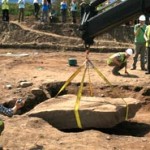 Archaeologists excavating the Forteviot site in Perthshire, Scotland, since 2006, have found evidence of the largest Stone Age henge complex in Scotland and now, a unique cist burial.
Archaeologists excavating the Forteviot site in Perthshire, Scotland, since 2006, have found evidence of the largest Stone Age henge complex in Scotland and now, a unique cist burial.
The 4 ton capstone was found last summer, but they weren’t able to lift it them. Now thanks to an industrial crane, the capstone has been removed to reveal a cist — a small buried coffin made of stone — containing artifacts and traces of human remains known infelicitously as “grave wax”.
“The real treasure of this burial is not the metal objects in it, but the organic remains,” [Aberdeen University’s Dr Gordon Noble] said. “This sort of material rarely survives in Scotland and it gives us an insight into what other objects were being used, not just the things that usually survive such as flint tools.
“The objects in the grave and its construction could equate to a high-status person to warrant such a burial,” he added. “To move a four-ton slab of stone in the Bronze Age was quite an undertaking.” […]
The capstone was found to have a unique carving of a spiral and axe shape on the side facing into the burial, while the cist itself had several axes or other weapons carved into the stone at the end where the head of its occupant is likely to have been.
The grave dates to between 2200 and 2100 BC, which is 400-500 younger than the estimated age of the huge henge.
The Forteviot site was an important one in the Middle Ages as well. A “palace” in Forteviot is mentioned as the death place of one of the first kings of united Scotland, Kenneth MacAlpin, who died in 858 AD.
Archaeologists are excavating a high-level medieval cemetary on the site hoping to find clues to the whereabouts of the purported palace, which isn’t likely to have borne much resemblance to our current notions of what a palace looks like.